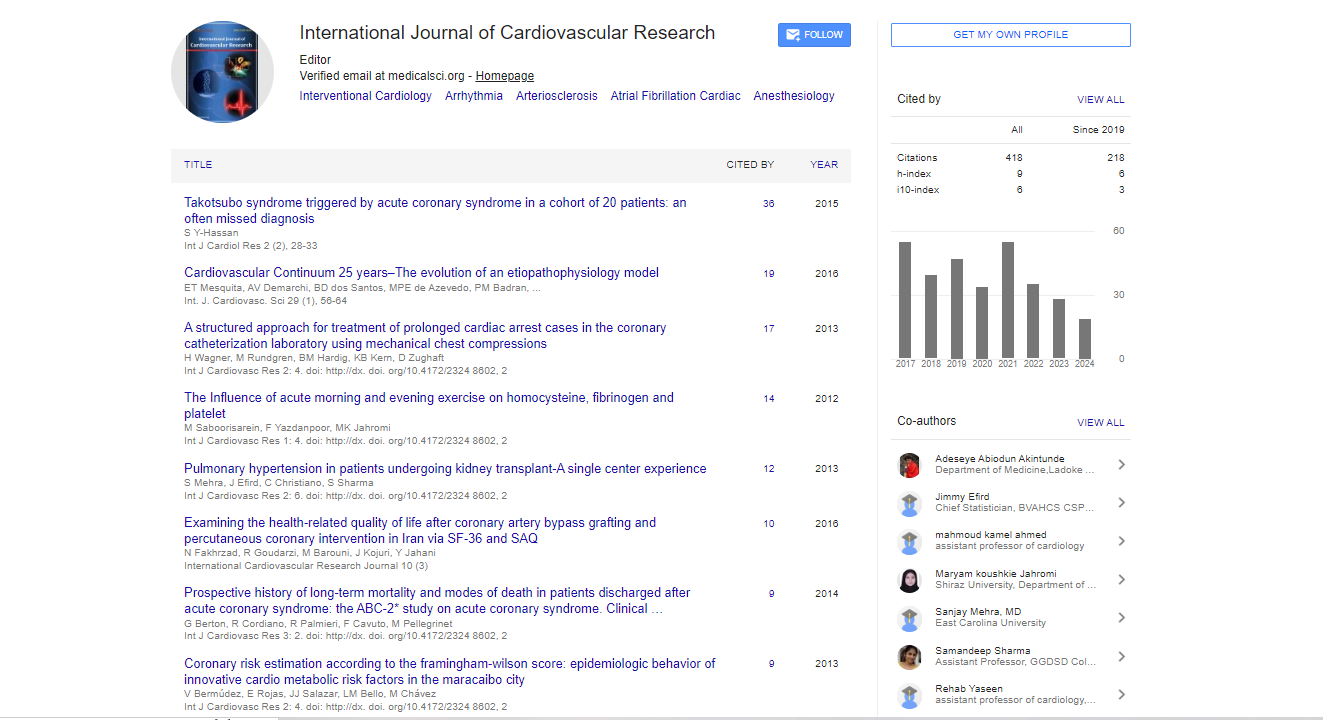Perspective, Int J Cardiol Res Vol: 13 Issue: 3
Advances in the Diagnosis and Treatment of Cardiomegaly
Jenna Khanna*
1Department of Cardiology ,Chulalongkorn University, Bangkok, Thailand
*Corresponding Author: Jenna Khanna,
Department of Cardiology, Chulalongkorn
University, Bangkok, Thailand
E-mail: khanna@gmail.com
Received date: 27 May, 2024, Manuscript No. ICRJ-24-144347;
Editor assigned date: 30 May, 2024, PreQC No. ICRJ-24-144347 (PQ);
Reviewed date: 13 June, 2024, QC No. ICRJ-24-144347;
Revised date: 21 June, 2024, Manuscript No. ICRJ-24-144347 (R);
Published date: 28 June, 2024, DOI: 10.4172/2324-8602.1000565
Citation: Khanna J (2024) Advances in the Diagnosis and Treatment of Cardiomegaly. Int J Cardiol Res 13:3.
Description
Cardiomegaly, an enlargement of the heart, is a clinical sign rather than a disease itself. It signifies underlying cardiac pathology and can manifest due to a variety of conditions affecting the heart's structure or function. Understanding cardiomegaly is important for clinicians in diagnosing and treating the underlying causes and improving patient outcomes. Cardiomegaly can result from a broad spectrum of cardiovascular and systemic conditions. It is typically categorized based on the underlying cause and the changes observed in the heart's structure. Chronic hypertension places increased pressure on the heart, leading to Left Ventricular Hypertrophy (LVH). The heart muscle thickens in response to the elevated workload, causing the heart to enlarge. Dilated Cardiomyopathy involves dilation and impaired contraction of the heart chambers, leading to reduced cardiac output and heart failure. Causes include genetic factors, viral infections and exposure to toxins. Hypertrophic cardiomyopathy is characterized by abnormal thickening of the heart muscle, this condition can obstruct blood flow and affect the heart's ability to pump efficiently. It is often inherited and may present with symptoms of heart failure or arrhythmias. Restrictive cardiomyopathy involves stiffness of the heart muscle, which inhibits filling of the ventricles. It can result from conditions such as amyloidosis or fibrosis. Certain congenital anomalies, such as ventricular septal defects or aortic stenosis, can lead to cardiomegaly due to increased workload or altered blood flow dynamics. Diseases affecting heart valves, such as aortic stenosis or mitral regurgitation, can lead to enlargement of the heart chambers due to increased pressure or volume overload.
Clinical presentation and diagnosis
Cardiomegaly can be asymptomatic or present with a range of symptoms depending on the underlying cause. Common symptoms include shortness of breath, fatigue, chest pain and palpitations. In severe cases, patients may experience symptoms of heart failure, such as edema and ascites. Diagnosis begins with a thorough clinical evaluation, including patient history and physical examination. Often the first diagnostic test, a chest X-ray can reveal an enlarged cardiac images about the underlying cause of cardiomegaly. Echocardiography is the primary tool for assessing cardiac structure and function. It provides detailed information on chamber size, wall thickness and cardiac function. Cardiac Magnetic Resonance Imaging (MRI) offers high resolution images of cardiac tissues and can be useful in evaluating complex cases and distinguishing between different types of cardiomyopathy. Electrocardiography (ECG) can identify abnormalities in heart rhythm and electrical conduction, which may be associated with cardiomyopathy. Blood tests can help identify markers of heart failure and assess for conditions contributing to cardiomegaly, such as thyroid dysfunction or anemia.
The presence of cardiomegaly often indicates an increased risk of heart failure and other cardiovascular complications. The severity of the enlargement and the underlying cause influence the clinical implications. Enlarged heart chambers can impair the heart's ability to pump effectively, leading to congestive heart failure. Symptoms include shortness of breath, fluid retention and reduced exercise tolerance. Structural changes in the heart can lead to abnormal electrical activity, increasing the risk of arrhythmias such as atrial fibrillation or ventricular tachycardia. Enlarged heart chambers, particularly in conditions like atrial fibrillation, can increase the risk of thrombus formation and subsequent embolic events. In severe cases, particularly with hypertrophic cardiomyopathy or advanced heart failure, there is a risk of sudden cardiac death.
The management of cardiomegaly focuses on treating the underlying cause and mitigating symptoms. Medications such as Angiotensin- Converting Enzyme (ACE) inhibitors, beta blockers and calcium channel blockers are used to manage hypertension and reduce cardiac workload. These help manage fluid overload and symptoms of heart failure. Medications to control abnormal heart rhythms may be prescribed if arrhythmias are present. Patients are often advised to make lifestyle changes, such as adopting a low-sodium diet, engaging in regular exercise and avoiding alcohol and tobacco. In cases of severe valvular or congenital heart disease, surgical repair or replacement of valves, or other corrective procedures, may be necessary. Implantable devices, such as pacemakers or defibrillators, may be recommended for patients with significant arrhythmias or advanced heart failure. Innovations in cardiomegaly continues to evolve, focusing on improving diagnostic techniques, understanding genetic and molecular mechanisms and developing novel therapeutic approaches. Advances in imaging technology, genomics and pharmacology increases the management of cardiomegaly and its underlying causes.
Conclusion
Cardiomegaly is a significant clinical finding with a diverse range of underlying causes and implications. A thorough understanding of its etiology, diagnosis and management is essential for optimizing patient care and outcomes. Continued study and advancements in medical technology will further enhance our ability to address cardiomegaly effectively, improving the lives of patients affected by this condition.
 Spanish
Spanish  Chinese
Chinese  Russian
Russian  German
German  French
French  Japanese
Japanese  Portuguese
Portuguese  Hindi
Hindi 



